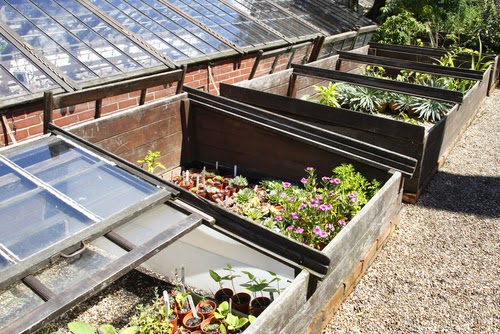Get a Head Start on Gardening with Cold Frames
by Tess Pennington
Not everyone is lucky enough to live in a temperate climate where they can create a year-round garden. Sometimes, we have to make do with what we have.
Using a cold frame is a great way to get a head start on your garden or as a way to extend your growing season during those cooler months.
Cold frames are essentially a mini-greenhouse where you utilize a transparent top (glass or plastic) to allow sunlight to come into the structure and prevent the heat to escape via convection that would otherwise occur, particularly at night. They create a microclimate that provides warmer air and soil temperature, as well as provides young plantlings with shelter from wind. In cold-winter or wet regions, these characteristics allow plants to be started earlier in the spring, and to survive longer into the fall and winter. The most simplistic way to create a cold frame is to add a piece of glass over a box. However, the larger the cold frame is, the more plants you can grow.
Widget not in any sidebars
Here are a few tips to keep in mind:
- Location of the cold frame can maximize plant growth
- Set the frame on bricks to limit the exposure to soil and moisture
- Angling the top of your cold frame towards the south will help you collect more sunlight for your plants
- Cold frames should be at least 12-18 inches deep in order to grow vegetables
- Warning: be wary of window frames with lead paint. Lead paint can seep into soil where your plants grow. Tests for lead-based paints are available at hardware stores.
Salvaging windows or plastic sheeting is a great way to make due with supplies you already have on hand. Plastic will not insulate the plants as much as glass will. Further, glass will create a stronger structure. It will especially be good to use glass for areas where large amounts of snow occur.
There are different ways to build a cold frame and some are more permanent structures, and some cold frames can be moved for a temporary location. Therefore, do some research on your part to find which way is best for you.
Delivered by The Daily Sheeple. Contributed by Tess Pennington of Ready Nutrition. Tess Pennington is the author of The Prepper’s Cookbook: 300 Recipes to Turn Your Emergency Food into Nutritious, Delicious, Life-Saving Meals. When a catastrophic collapse cripples society, grocery store shelves will empty within days. But if you follow this book’s plan for stocking, organizing and maintaining a proper emergency food supply, your family will have plenty to eat for weeks, months or even years.




